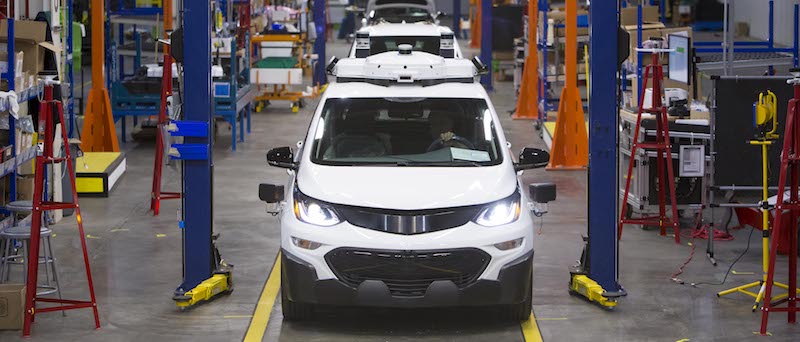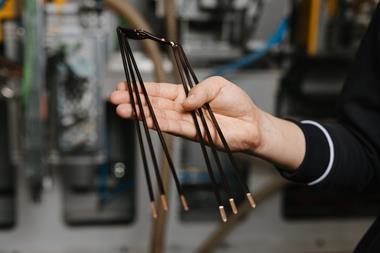Reinventing itself as a high-tech leader since its 2009 bankruptcy, GM has set out an ambitious timeframe to launch more than 20 all-electric vehicles vehicles
 In science-fiction films of old, the 21st century was meant to be awash with technologies transforming our lives. Soon after the century ticked over, General Motors (GM) was painted as “the baddie”, unwilling to let go of the past. Much of that was due to the 2006 film Who killed the electric car? – a borderline hysterical documentary that presented compelling conspiracy theories explaining why GM had crushed nearly all remaining examples of its groundbreaking 1996 car, the EV1.
In science-fiction films of old, the 21st century was meant to be awash with technologies transforming our lives. Soon after the century ticked over, General Motors (GM) was painted as “the baddie”, unwilling to let go of the past. Much of that was due to the 2006 film Who killed the electric car? – a borderline hysterical documentary that presented compelling conspiracy theories explaining why GM had crushed nearly all remaining examples of its groundbreaking 1996 car, the EV1.
A little over ten years later, and the film’s premise is shot to pieces, at least as far as GM is concerned. After reinventing itself as a high-tech leader following the painful bankruptcy of 2009, GM is now at the forefront of electric vehicle (EV) development. GM executives have privately expressed regret for destroying evidence that it led the way in EV research with the EV1. Given how hard automotive brands now push successful or innovative past models for marketing purposes, it is easy to see why.
The US• 2018 to 2020: Four new electric vehicles to be built on Bolt’s BEV2 platform, two of which will be SUVs.• From 2021: New EV architecture that will underpin 11 new models, including seven new SUVs, one ‘shared’ people carrier, one light commercial vehicle and two cars.
China• 2016 to 2020: ten electrified vehicles, three of which have already been launched. Includes Buick, Cadillac, Chevrolet, Baojun and Wuling brands.• By 2025: New models launched under the Buick, Cadillac and Chevrolet brands will be electrified.
More: read our interview with GM's VP for global electric vehicle programs, Pamela Fletcher...
In China, a country that has aggressively targeted EV growth by forcing future targets on manufacturers, GM has vowed to launch at least ten new electric or hybrid vehicles between 2016 and 2020. It plans to offer “electrification technology” on nearly all models from its GM, Cadillac and Chevrolet brands in the country by 2025, and is already targeting the lower end of the EV market with the launch of the E100 two-seater – a product of Baojun, its low-cost brand with joint venture partner SAIC.
A question mark over spendingIt is not yet clear how much GM will spend on all these plans. Unlike many of its EV-bullish rivals such as Ford, which recently announced an $11 billion commitment to electrification, GM has not put a price on its future research and development. It is safe to say it will probably be in the billions. The company already has 1,700 engineers working on batteries and EVs, many of which are located at its technical centre in Warren, Michigan. A report by Reuters noted that the OEM took out 661 US patents on battery technology between 2010 and 2015 – second only to Toyota.
GM currently builds one of the more compelling EVs on sale today in terms of range, usability and technological jump on its rivals. The Chevrolet Bolt EV (the Ampera-E in Europe), was launched in 2016 with a claimed 238-mile range, a US sticker price of $37,000 and a 60kWh battery pack using the latest, most energy-dense LG Chem pouch cells. The Bolt’s chief engineer, and now head of GM’s entire EV programme, Pamela Fletcher, boasted that GM was “first to market with an affordable, high-range electric car”, beating Tesla with its Model 3. Only the similarly timed launch of the longer-range Renault Zoe. also with LG Chem pouch cells, spoilt GM’s claim.
The Bolt is selling well, or at least as well as can be expected in what is still a tiny market. In 2017 the Bolt, which is built in GM’s Orion, Michigan, plant was the third bestselling EV in the US after the Tesla Model S and Model X, with sales of 23,297. The Nissan Leaf was fourth, with sales at half those of the Bolt. But in Europe, the story is not so rosy; just 1,681 Bolt EVs were sold in the first 11 months of 2017, according to figures from JATO Dynamics. Given GM’s pullout of Europe, the car is not expected to continue to feature in Opel’s range for long.
Losing money, but for how long?The financial analyst arm of the UBS bank estimates that GM loses $7,400 on every Bolt sold, after the company tore down one of the cars to cost up all its parts. In the resulting report, published May last year, UBS estimated that the price of the battery pack was $11,500-12,500, of which the cells were reckoned to account for $8,700. The cost of the EV powertrain was a massive $9,000 more than one used in a similarly sized VW Golf TSI with a petrol engine, meaning the Bolt was $9,500 more expensive to produce than a Golf.
GM admits that it loses money building electric cars but is confident it can move to profitability in around three years. In a presentation made in November last year, Barra said that the current battery cost of $145 per kWh for the Bolt will reduce to $100 or less with the launch of the 2021 EV architecture, which includes a new battery chemistry. Costs will also fall with rising sales, as well as the use of less complicated manufacturing techniques.

UBS already concluded the same thing during its deep-dive of the Bolt’s composition. The company estimated that the Bolt’s $8,700 worth of cells will drop to $5,400 in 2025 through a reduction in the use of cobalt – the costliest ingredient of lithium-ion cells and one that recently hit a record high on the markets.
Excluding the battery pack, the Bolt’s powertrain is actually 16% cheaper than the Golf’s engine and gearbox combination, and a lot simpler. In total, UBS reckoned that the Bolt’s powertrain was $4,600 cheaper than it originally predicted. As for the suppliers, UBS estimated that LG components equate for around 56% of content in the vehicle.
The Korean company also makes the battery packs at its factory in Holland, Michigan. LG has plans to extend its plant, increasing the number of production lines to five, according to reports from Korea’s Electronic Times. This will provide the company with enough capacity to produce 50,000 packs for the Bolt every year.
GM has its own battery pack plant in Brownstown, Michigan, which supplies packs for the Chevrolet Volt plug-in hybrid, GM’s mild hybrid pick-up trucks, the new Cadillac CT-6 plug-in hybrid and the Buick Lacrosse hybrid. It also makes replacement packs for the discontinued Chevrolet Spark EV city car, which was the company’s first EV; the unloved Cadillac ELR plug-in hybrid; and the first-generation Chevrolet Volt.
 The Baojun E100 is an EV produced by GM-SAIC in China
The Baojun E100 is an EV produced by GM-SAIC in ChinaThe OEM also opened a new battery assembly plant in Shanghai last year with its joint venture partner SAIC. Along with the Baojun E100, GM-SAIC sells the Buick Velite 5 plug-in hybrid, which is a version of the Chevy Volt, and the Cadillac CT6 plug-in hybrid.
The autonomous connectionGM is very keen to connect its investment in EVs with its cash-intensive investment in autonomous technology, possibly to amplify the buzz around potentially lucrative future technologies to investors, but also because it is practical. “EV is a foundation for autonomous vehicles,” Barra stated during the Barclays Global Automotive Conference. She suggested that it was simpler to integrate autonomous driving technologies into an electric car, and that the combination makes sense for urban environments. It also reflects GM’s ‘zero, zero, zero’ marketing message – zero crashes, zero emissions and zero congestion. The OEM has started building autonomous versions of its Bolt EV on the Orion production line to join its autonomous test fleet. These units are called Cruise AV, and have no driver controls. GM has said it would debut a self-drive fleet for public use via a ride-hailing service sometime in 2019.
As with many manufacturers promising dizzying numbers of EVs in the future, GM is still hazy on details such as where the models will be made. It also is not clear if the OEM will replicate the recipe for the Bolt EV, with some media reports in China suggesting that GM could ditch LG Chem in favour of a local cell-maker to get around Chinese penalties on Korean battery suppliers.
As GM looks to start making electric SUVs (a plan Barra alluded to at the Barclays conference), it seems that what is currently a loss-making exercise could become a viable strategy in quite a short space of time – amazing, really, for a manufacturer that still makes the bulk of its profits from selling gas-guzzling pick-up trucks.
More: read our interview with GM's VP for global electric vehicle programs, Pamela Fletcher...





































